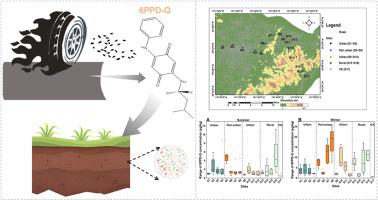当前位置:
X-MOL 学术
›
Environ. Pollut.
›
论文详情
Our official English website, www.x-mol.net, welcomes your
feedback! (Note: you will need to create a separate account there.)
The spatio-temporal accumulation of 6 PPD-Q in greenbelt soils and its effects on soil microbial communities
Environmental Pollution ( IF 7.6 ) Pub Date : 2024-06-29 , DOI: 10.1016/j.envpol.2024.124477 Wei Wu 1 , Qiao Xu 2 , Jinhu Li 2 , Zhen Wang 3 , Gang Li 4
Environmental Pollution ( IF 7.6 ) Pub Date : 2024-06-29 , DOI: 10.1016/j.envpol.2024.124477 Wei Wu 1 , Qiao Xu 2 , Jinhu Li 2 , Zhen Wang 3 , Gang Li 4
Affiliation

|
6 PPD-Q (6 PPD-Quinone) is an ozone-induced byproduct derived from the degradation of N -(1,3-dimethylbutyl)-N′ -phenyl-p -phenylenediamine (6 PPD), commonly found in road dust resulting from tire wear. However, the extent of 6 PPD-Q pollution in urban soil remains unclear. This study investigates the spatial and temporal accumulation patterns of 6 PPD-Q in greenbelt soils in Ningbo, and explores the correlation between 6 PPD-Q accumulation and soil microbial community composition and functions. Our findings indicate that 6 PPD-Q is present (ranging from 0.85 to 12.58 μg/kg) in soil samples collected from both sides of urban traffic arteries. Soil fungi exhibit higher sensitivity to 6 PPD-Q accumulation compared to bacteria, and associated fungi (Basidiomycota) may be potential biomarkers for environmental 6 PPD-Q contamination. Co-occurrence network analysis reveals that the bacterial microbial network in summer exhibits greater stability and resilience in response to 6 PPD-Q inputs than in winter. However, 6 PPD-Q accumulation disrupts the network structure of fungal communities to some extent, leading to reduced diversity in fungal microbial communities. Long-term accumulation of 6 PPD-Q weakens the nitrogen and phosphorus cycling potential within urban soil, while the enhancement of carbon cycling may further promote 6 PPD-Q degradation in urban soil. Taken together, this study provides new insights into the ecological risks of 6 PPD-Q in urban soils.
中文翻译:

绿地土壤中6种PPD-Q的时空积累及其对土壤微生物群落的影响
6 PPD-Q (6 PPD-Quinone) 是一种由臭氧引起的副产品,源自 N-(1,3-二甲基丁基)-N'-苯基-对苯二胺 (6 PPD) 的降解,常见于道路灰尘中,从而产生来自轮胎磨损。然而,城市土壤中6 PPD-Q污染的程度仍不清楚。本研究调查了宁波市绿地土壤中6-PPD-Q的时空积累规律,探讨了6-PPD-Q积累与土壤微生物群落组成和功能的相关性。我们的研究结果表明,从城市交通干线两侧收集的土壤样本中存在 6 PPD-Q(范围为 0.85 至 12.58 μg/kg)。与细菌相比,土壤真菌对 6 PPD-Q 积累表现出更高的敏感性,相关真菌(担子菌门)可能是环境 6 PPD-Q 污染的潜在生物标志物。共现网络分析表明,夏季细菌微生物网络对 6 个 PPD-Q 输入的响应表现出比冬季更高的稳定性和弹性。然而,6 PPD-Q的积累在一定程度上扰乱了真菌群落的网络结构,导致真菌微生物群落的多样性降低。 6 PPD-Q的长期积累削弱了城市土壤内的氮磷循环潜力,而碳循环的增强可能进一步促进城市土壤中6 PPD-Q的降解。总而言之,这项研究为城市土壤中 6 PPD-Q 的生态风险提供了新的见解。
更新日期:2024-06-29
中文翻译:

绿地土壤中6种PPD-Q的时空积累及其对土壤微生物群落的影响
6 PPD-Q (6 PPD-Quinone) 是一种由臭氧引起的副产品,源自 N-(1,3-二甲基丁基)-N'-苯基-对苯二胺 (6 PPD) 的降解,常见于道路灰尘中,从而产生来自轮胎磨损。然而,城市土壤中6 PPD-Q污染的程度仍不清楚。本研究调查了宁波市绿地土壤中6-PPD-Q的时空积累规律,探讨了6-PPD-Q积累与土壤微生物群落组成和功能的相关性。我们的研究结果表明,从城市交通干线两侧收集的土壤样本中存在 6 PPD-Q(范围为 0.85 至 12.58 μg/kg)。与细菌相比,土壤真菌对 6 PPD-Q 积累表现出更高的敏感性,相关真菌(担子菌门)可能是环境 6 PPD-Q 污染的潜在生物标志物。共现网络分析表明,夏季细菌微生物网络对 6 个 PPD-Q 输入的响应表现出比冬季更高的稳定性和弹性。然而,6 PPD-Q的积累在一定程度上扰乱了真菌群落的网络结构,导致真菌微生物群落的多样性降低。 6 PPD-Q的长期积累削弱了城市土壤内的氮磷循环潜力,而碳循环的增强可能进一步促进城市土壤中6 PPD-Q的降解。总而言之,这项研究为城市土壤中 6 PPD-Q 的生态风险提供了新的见解。
















































 京公网安备 11010802027423号
京公网安备 11010802027423号